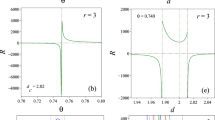Abstract
In this work we consider the Wulff construction at zero temperature for a class of Gibbs models and study the shape of the obtained droplets. Considering zero temperature we avoid all difficulties connected with the competition between energy and entropy. It allows us to study a quite wide class of models which provides a variety of shapes. The motivations of the study come from attempts to describe isotropic properties of some models on 2D lattice at zero temperature. The studied models are binary (the spin space is 0,1) with a ferromagnetic behavior such that the potential functions are not equal to zero only for some tiles with size 3×3. In fact, we study herein droplet shapes of a subclass of the ferromagnetic models with potential functions as mentioned above. This subclass of models is defined by a condition called regularity. We call the model classified here as having regular micro-boundaries. Several examples of non-regular models are also presented.
Similar content being viewed by others
REFERENCES
X. Descombes and E. Pechersky, Isotropic Properties of Some Multi-Body Interaction Models: Two Quality Criteria for Markov Priors in Image Processing, Technical report INRIA, RR-3752, 1999.
R. A. Minlos and Ya. G. Sinai, The phenomenon of "phase separation" at low temperatures in some lattice models of a gas I, Math. USSR-Sb. 2:337-395 (1967).
R. A. Minlos and Ya. G. Sinai, The phenomenon of "phase separation" at low temperatures in some lattice models of a gas II, Trans. Moscow Math. Soc. 19:121-196 (1968).
R. L. Dobrushin, R. Koteckáy, and S. Shlosman, Wulff Construction: A Global Shape from Local Interaction, AMS Translations Series, Vol. 104 (Providence, R.I., 1992).
T. Bodineau, D. Ioffe, and Y. Velenik, Rigorous Probabilistic Analysis of Equibrial Crystal Shapes, 2000.
J. Beseag, Spatial interaction and statistical analysis of lattice systems, J. Roy. Soc. Ser. B 48:192-236, 1974.
S. Geman and D. Geman, Stochastic relaxation, Gibbs distribution, and the Bayewsian restoration of images, IEEE Trans. on PAMI 6:721-741, 1984.
Ya. G. Sinai, Theory of Phase Transitions: Rigorous Results (Pergamon Press, 1982).
H-O. Georgii, Gibbs Measures and Phase Transitions (Walter de Gruyter, 1988).
X. Descombes, J. F. Mangin, E. Pechersky, and M. Sigelle, Fine structure preserving Markov model for image processing, in Proc. SCIA (Uppsala, Sweden, 1995), pp. 349-056.
X. Descombes, R. Morris, J. Zerubia, and M. Berthod, Estimation of markov random field prior parameters using Markov Chain Monte Carlo Maximum Likelihood, IEEE Trans. on Image Processing 8:954-963 (1999).
X. Descombes and F. Kruggel, A Markov Pixon information approach for low level image description, IEEE Trans. on Pattern Anaylsis and Machine Intelligence 21:482-494 (1999).
Author information
Authors and Affiliations
Rights and permissions
About this article
Cite this article
Descombes, X., Pechersky, E. Droplet Shapes for a Class of Models in \(\mathbb{Z}^2 \) at Zero Temperature. Journal of Statistical Physics 111, 129–169 (2003). https://doi.org/10.1023/A:1022252923753
Issue Date:
DOI: https://doi.org/10.1023/A:1022252923753




